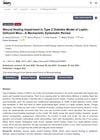Risk Factors for Diabetic Foot Ulcers Mortality and Novel Negative Pressure Combined with Platelet-Rich Plasma Therapy in the Treatment of Diabetic Foot Ulcers
December 2022
in “
Frontiers in Pharmacology
”
TLDR Combining negative pressure therapy with platelet-rich plasma speeds up healing and lowers death risk in diabetic foot ulcers.
This study investigated risk factors for morbidity and mortality in diabetic foot ulcers (DFUs) and evaluated the effectiveness of combining negative pressure wound therapy (NPWT) with platelet-rich plasma-fibrin glue (PRP) in treating DFUs. The study included 1,163 patients, with 653 having DFUs and 510 without. Blood indicators such as C-reactive protein, albumin, and creatinine were identified as predictors of DFU morbidity, while albumin and age were independent predictors of mortality. The combination of NPWT and PRP was found to accelerate wound healing and reduce mortality compared to NPWT alone, suggesting it as an effective adjunct treatment for DFUs.





